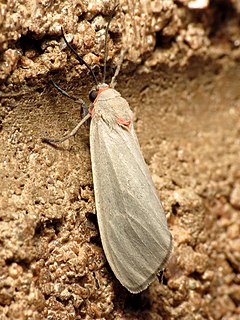
The Luna moth is a Nearctic moth in the family Saturniidae, subfamily Saturniinae, a group commonly known as giant silk moths. It has lime-green colored wings and a white body. The larvae (caterpillars) are also green. Typically, it has a wingspan of roughly 114 mm (4.5 in), but can exceed 178 mm (7.0 in), making it one of the larger moths in North America. Across Canada, it has one generation per year, with the winged adults appearing in late May or early June, whereas farther south it will have two or even three generations per year, the first appearance as early as March in southern parts of the United States.

The light brown apple moth is a leafroller moth belonging to the lepidopteran family Tortricidae.

Phthorimaea operculella, also known as the potato tuber moth or tobacco splitworm, is a moth of the family Gelechiidae. It is an oligophagous insect that feeds on the plant family Solanaceae and is especially known for being a major pest of potato crops. Currently farmers utilize insecticides, parasites, and sprinkler irrigation in order to prevent P. operculella from infesting their croplands.

Palpita vitrealis, common name jasmine moth or white pearl, is a species of moth of the family Crambidae.

Sesia bembeciformis, the lunar hornet moth, is a moth of the family Sesiidae. It is found in Europe.

Synanthedon spheciformis, the white-barred clearwing, is a moth of the family Sesiidae. It is found in Europe and Siberia.

Cerura erminea is a moth of the family Notodontidae, also known as the lesser puss moth or feline. It is found in Europe.
Pygarctia is a genus of moths in the family Erebidae.
Geshna is a monotypic moth genus of the family Crambidae described by Harrison Gray Dyar Jr. in 1906. It contains only one species, Geshna cannalis, the lesser canna leafroller, described by Altus Lacy Quaintance in 1898. It is found in North America, where it has been recorded from Florida, Mississippi, South Carolina, North Carolina and Tennessee. It has also been recorded from Costa Rica and Cuba.

Thaumatotibia (Cryptophlebia) leucotreta, commonly known as the false codling moth, orange moth, citrus codling moth or orange codling moth, is a moth in the family Tortricidae under the order of Lepidoptera. Larvae of the moth feed on a wide range of crops from cotton and macadamia nuts to Citrus species. The larvae have a less selective diet than the codling moth, which feeds primarily on temperate fruit crops.

Coleophora trochilella is a moth of the family Coleophoridae. It is found in all of Europe, with possible exception of parts of the Balkan Peninsula.

Exoteleia dodecella, the pine bud moth, is a moth of the family Gelechiidae. It is widely distributed from western Europe to Siberia. It is an introduced species in North America.

Cnephasia longana, the omnivorous leaftier moth, long-winged shade or strawberry fruitworm, is a moth of the family Tortricidae. It was described by Adrian Hardy Haworth in 1811. It is native to western Europe. It is an introduced species in western North America. The species has also been reported from north-western Africa and Asia. The habitat consists of downland and rough ground.
Pygarctia abdominalis, the yellow-edged pygarctia or orange-bodied pygarctia, is a moth in the family Erebidae. It was described by Augustus Radcliffe Grote in 1871. It is found in the United States from New Jersey south to Florida and west to Texas.
Pygarctia eglenensis, the gray-winged pareuchaetes, is a moth in the family Erebidae. It was described by James Brackenridge Clemens in 1861. It is found in the US states of Texas and Florida.
Pygarctia flavidorsalis is a moth in the family Erebidae. It was described by William Barnes and James Halliday McDunnough in 1913. It is found in the US states of Arizona and Texas. There is also a record for Oklahoma.
Pygarctia lorula is a moth in the family Erebidae. It was described by Harrison Gray Dyar Jr. in 1914. It is found in the US state of New Mexico.

Pygarctia murina, the mouse-colored euchaetias, is a moth in the family Erebidae. It was described by Richard Harper Stretch in 1885. It is found in the United States in south-western Utah, from southern Colorado to south-eastern California and in southern Texas.
Pygarctia pterygostigma is a moth in the family Erebidae. It was described by Harrison Gray Dyar Jr. in 1909. It is found in Mexico, and in the United States, in New Mexico and southern Texas.
Rhectocraspeda periusalis, the eggplant webworm moth, is a moth in the family Crambidae. It was described by Francis Walker in 1859. It is found in the West Indies and from the United States, where it has been recorded from Florida, North Carolina, Ohio, Oklahoma, South Carolina and Tennessee, south through Mexico and Central America to South America, including Ecuador, Brazil, Guyana, Trinidad and Tobago and Suriname.












